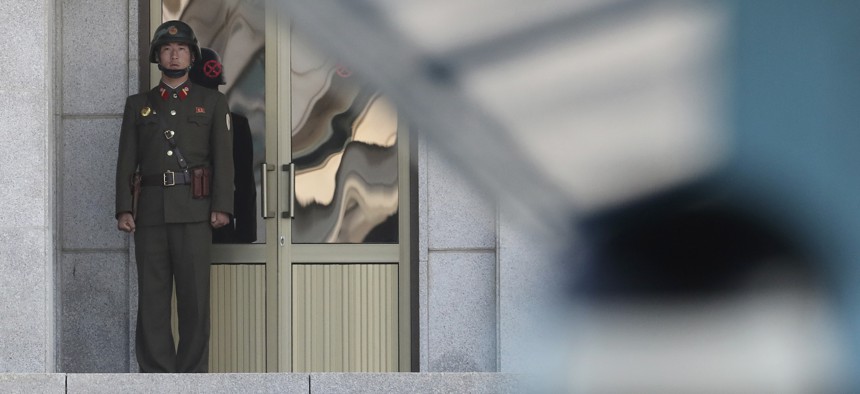
A North Korean soldier, left, looks at the South side as a South Korean soldier, right, stands guard at the truce village of Panmunjom in the Demilitarized Zone in Paju, South Korea, Sept. 28, 2017. Lee Jin-man/AP
How to Tell If North Korea and America Are Actually Headed to War
Watch what Donald Trump and Kim Jong Un do, not just what they say.
There are moments—like when the American president threatens to “totally destroy” the nation of North Korea and its raving mad “Little Rocket Man” of a leader, while the North Koreans suggest they’ll retaliate against this “declaration of war” from a “mentally deranged U.S. dotard” by downing U.S. military planes and exploding a hydrogen bomb over the Pacific Ocean—when one gets the distinct impression that the United States and North Korea are headed for war.
But while words matter, they aren’t all that matter. Actions may be a better indicator of where the crisis stands and what could come next. And the governments of the alleged dotard and Rocket Man have been taking actions that tell a different story than the apocalyptic rhetoric does.
On Tuesday, for example, the Trump administration announced new U.S. sanctions against North Korea. On Thursday, Secretary of State Rex Tillerson begins a visit to China, which at America’s urging has restricted its trade and financial ties with North Korea and supported two rounds of UN Security Council sanctions against the North. Those are steps you take when you retain hope that diplomatic isolation and economic deprivation will compel Kim Jong Un’s regime to accept a negotiated settlement of the nuclear standoff. Donald Trump has mobilized military resources—installing a missile-defense system in South Korea, proceeding with annual U.S.-South Korean military drills, and most recently flying U.S. bombers and fighter jets just off North Korea’s eastern coast in a show of “resolve.” But these are measures designed to deter North Korean aggression and defend the United States and its allies should deterrence fail, not signs that America is readying for war.
As Joseph Dunford, the chairman of the Joint Chiefs of Staff, explained to the Senate Armed Services Committee on Tuesday, the Trump administration is in the midst of “a pressurization campaign” led by Tillerson and contingent on Chinese cooperation. It involves “applying economic and diplomatic means primarily to force the North Koreans” to give up their nuclear weapons, and making clear that Trump has “military options” if the campaign doesn’t work. “We’re at the phase now where implementation of the sanctions is going to determine whether or not we have a peaceful solution to denuclearization on the [Korean] peninsula,” Dunford said. The administration appears to be taking the economic dimension of this effort more seriously than the diplomatic effort; Trump has yet to fill the positions of U.S. ambassador to South Korea or assistant secretary of state for East Asian and Pacific Affairs. But whatever the case, the U.S. military is playing a supporting role at the moment.
If war was imminent, we would likely see something we haven’t yet: an evacuation of Americans—civilians, military family members, non-essential personnel—from South Korea, according to Abe Denmark, who served as deputy assistant secretary of defense for East Asia under Barack Obama. “It’s impossible to hide because it’s over 100,000 people,” he said, and it “would signal that things are getting really dangerous.”
“If you’re actually going to go to war, you have to do a lot of things—primarily in terms of logistics and communications and mobilizing reserve forces … and you don’t see any of those on the [U.S.-South Korean forces] side to the south of the [Korean Demilitarized Zone] nor to the north of it,” said Dennis Blair, a former director of national intelligence and commander of U.S. forces in the Pacific. In 1994, for instance, when Blair was commanding a battle group in the western Pacific and the Clinton administration nearly decided to strike a North Korean nuclear reactor, Blair’s deployment was diverted from the Persian Gulf to Korea, Patriot anti-missile batteries flowed into the region, and a range of military units were put on alert to carry out war plans against North Korea.
“On the North Korean side, I can’t talk in as much detail, but it’s the logical things you would do if you have a fairly large North Korean army, an infantry-heavy army, and you don’t keep all of the soldiers in readiness all of the time, you don’t keep all of the supplies brought up, the ammunition broken out, the wartime command-and-control modes set up,” Blair added. U.S. officials “monitor very closely those indicators and none of our leaders has spoken publicly saying that those indicators have been activated.”
Dunford, in fact, told senators this week that North Korea’s military activities have not matched the government’s escalating rhetoric. The United States hasn’t detected a “change in the posture of North Korean forces” as a result of the “charged political environment,” he testified. A South Korean lawmaker who heads the legislature’s intelligence committee claims that the Kim regime is seeking to avoid accidental conflict by ordering soldiers to report up the chain of command before taking any military action. North Korean propaganda may loudly and confidently condemn Trump as the “trouble-maker of humanity,” but North Korean officials are quietly struggling to square Trump’s fiery tweets with the sober statements of his advisers, and reportedly reaching out to American Korea experts in search of clarity.
While Kim Jong Un has mostly refrained from perpetrating violent acts directly against the United States and South Korea—in contrast to his father and grandfather—the North Korean leader has dramatically accelerated the development of the country’s nuclear-weapons arsenal. He’s carried out a flurry of missile and nuclear tests, including the likely detonation of a hydrogen bomb and two ballistic-missile tests over Japanese territory, that have been far more aggressive than any recent actions of the United States toward North Korea. Nevertheless, according to Blair, Kim appears to think about these tests the way Kim Jong Il and Kim Il Sung thought about aggressive behavior outside North Korea’s borders—as “tools to keep the country stirred up so he can justify his brutal regime, keep his enemies divided, [and] try to gain concessions” from other countries without crossing the “threshold of provocation above which the United States and the Republic of Korea will go to war.”
The greatest danger may be that the U.S.-North Korean war of words morphs into actual war through miscalculation. Demonstrations of U.S. military capabilities like the recent flight of bombers near North Korea can be “stabilizing” during times of crisis, Denmark said, but not when paired with messages like the one Trump sent on Twitter shortly after the demonstration—that if Kim Jong Un continues to threaten the United States, he might not “be around much longer.”
It’s unclear whether North Korea can really shoot down U.S. war planes, Denmark noted, but “if the president keeps talking about total destruction of North Korea, and has a vague definition of what would cause that, and [says the North Korean leadership is] not going to be around for very much longer, and then [the North Koreans] see a flight of American aircraft flying towards North Korea, how are they supposed to interpret that?”
This week, Senator Angus King put that question to Dunford. “I have a queasy feeling that we’re in 1914 stumbling toward Sarajevo,” he said. What if, King wondered, North Korea mistakes an exercise involving a U.S. Navy vessel for an attack on the Kim government and attempts to destroy the ship, sparking tit-for-tat violence that spirals into all-out warfare? Dunford tried to reassure the senator by noting that he had spent hours reviewing plans for the bomber run along North Korea’s coast, but King wasn’t reassured. He asked whether the U.S. military has a way to communicate to the North Korean military that the United States is merely conducting a drill. “We do not,” Dunford answered. King asked whether it was sensible for U.S. leaders to threaten to destroy the Kim regime when Kim Jong Un is determined to acquire nuclear weapons precisely because he wants to prevent the destruction of his regime. “I have been very careful at the military level to make no statements that would exacerbate the current crisis,” Dunford responded. “I certainly won’t comment on things that our senior political leadership have said.”
Blair, however, insists that we’re probably not on the brink of war, whether deliberate or unintentional. The military situation on the Korean peninsula is “fairly stable” despite the high level of readiness of both sides, he argues, and rhetoric “counts for very little.”
“North Korea uses bloodthirsty, shocking rhetoric ... strictly for effect, and it has very little to do with what they are actually doing or planning to do,” Blair said. “On the American side, this is the first time that a president has gotten down into the gutter with a North Korean leader and used the same harsh rhetoric against him.” But so far, that unprecedented approach has not had a corresponding impact on U.S. military preparations or action.
What we’re witnessing, Blair argued, is “two dogs barking on either side of a chain-link fence. It’s actually two chain-link fences. There’s a chain-link fence on the North Korean side … which is staying below the level of provocation they think would start a war, and on the American side it’s just a natural reluctance to cause escalation because [the South Korean capital of] Seoul is so close to the DMZ. The North Koreans have a large number of artillery tubes which could cause a lot of death and destruction within the time it would take us to suppress that artillery.”
“Both sides have military restraints on them and both dogs are barking pretty furiously, primarily for domestic consumption,” he told me. “Neither of them has any idea of the effect on the other, and I think the effect on the other is very little.”




